Research Methodology: Gender Diversity and Financial Performance
VerifiedAdded on 2023/01/07
|9
|2662
|50
Report
AI Summary
This report presents a research proposal examining the effects of gender-diverse teams on financial performance within the retail sector, specifically focusing on Sainsbury's. The study aims to determine how workforce diversity, encompassing factors like age, culture, and gender, can enhance business performance. The research includes an overview of the research, its purpose, rationale, research aims, objectives, and questions. The methodology will employ a mixed-method approach, using both qualitative and quantitative data collection methods, including surveys and secondary data analysis. The research philosophy will be pragmatism, and data analysis will involve thematic analysis and statistical techniques to assess the relationship between gender diversity and financial outcomes. Ethical considerations and a timeline for completion are also included.
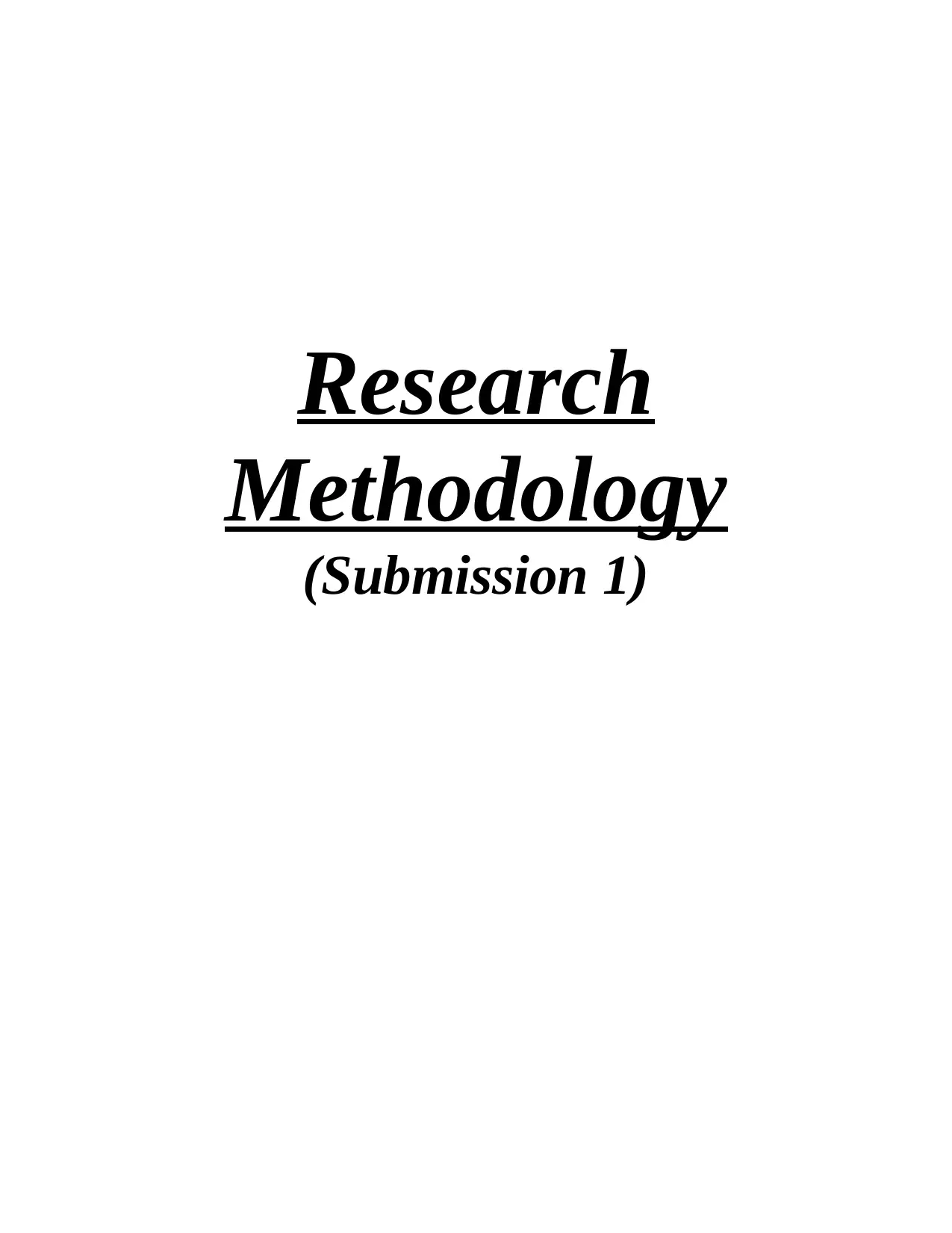
Research
Methodology
(Submission 1)
Methodology
(Submission 1)
Paraphrase This Document
Need a fresh take? Get an instant paraphrase of this document with our AI Paraphraser
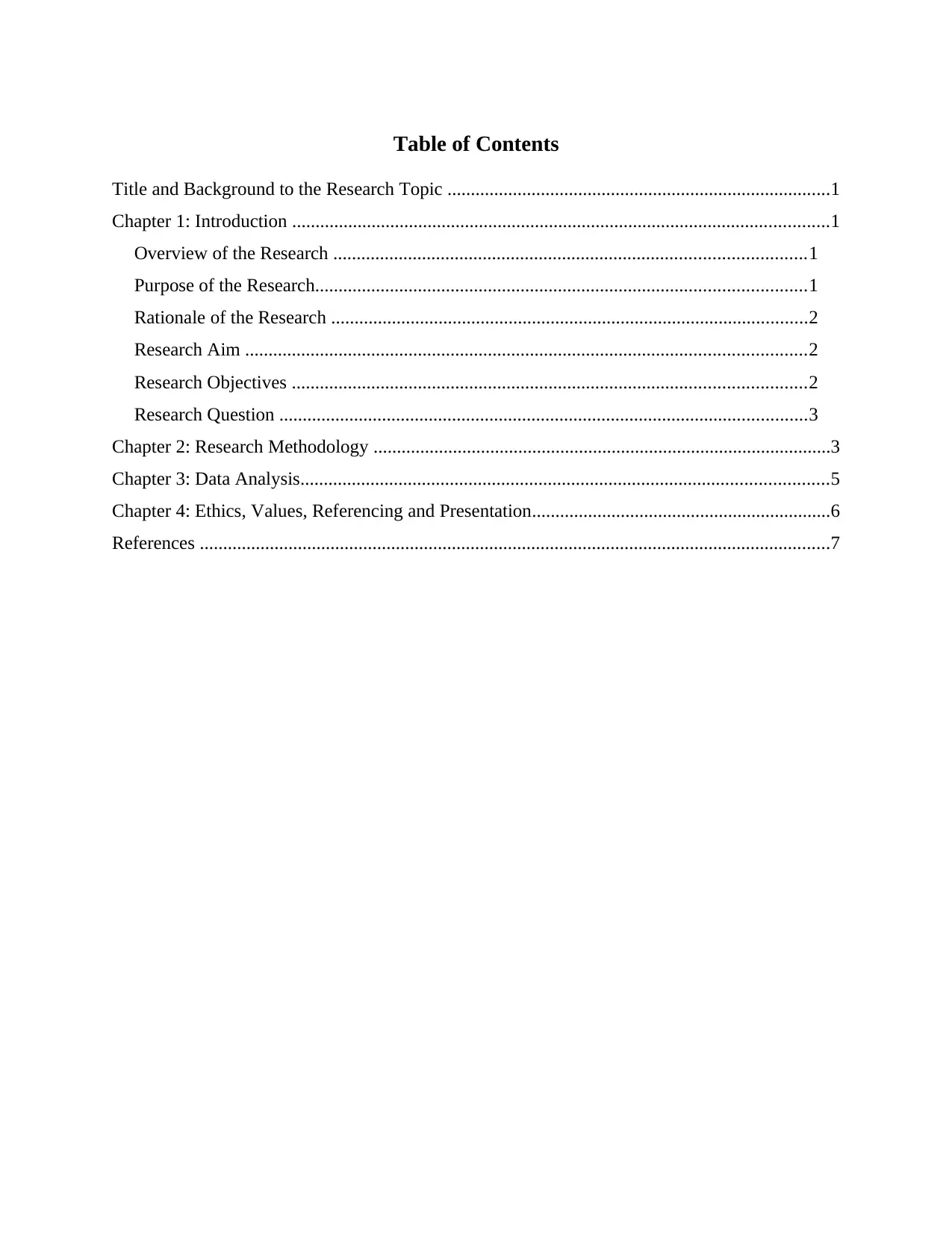
Table of Contents
Title and Background to the Research Topic ..................................................................................1
Chapter 1: Introduction ...................................................................................................................1
Overview of the Research .....................................................................................................1
Purpose of the Research.........................................................................................................1
Rationale of the Research ......................................................................................................2
Research Aim ........................................................................................................................2
Research Objectives ..............................................................................................................2
Research Question .................................................................................................................3
Chapter 2: Research Methodology ..................................................................................................3
Chapter 3: Data Analysis.................................................................................................................5
Chapter 4: Ethics, Values, Referencing and Presentation................................................................6
References .......................................................................................................................................7
Title and Background to the Research Topic ..................................................................................1
Chapter 1: Introduction ...................................................................................................................1
Overview of the Research .....................................................................................................1
Purpose of the Research.........................................................................................................1
Rationale of the Research ......................................................................................................2
Research Aim ........................................................................................................................2
Research Objectives ..............................................................................................................2
Research Question .................................................................................................................3
Chapter 2: Research Methodology ..................................................................................................3
Chapter 3: Data Analysis.................................................................................................................5
Chapter 4: Ethics, Values, Referencing and Presentation................................................................6
References .......................................................................................................................................7
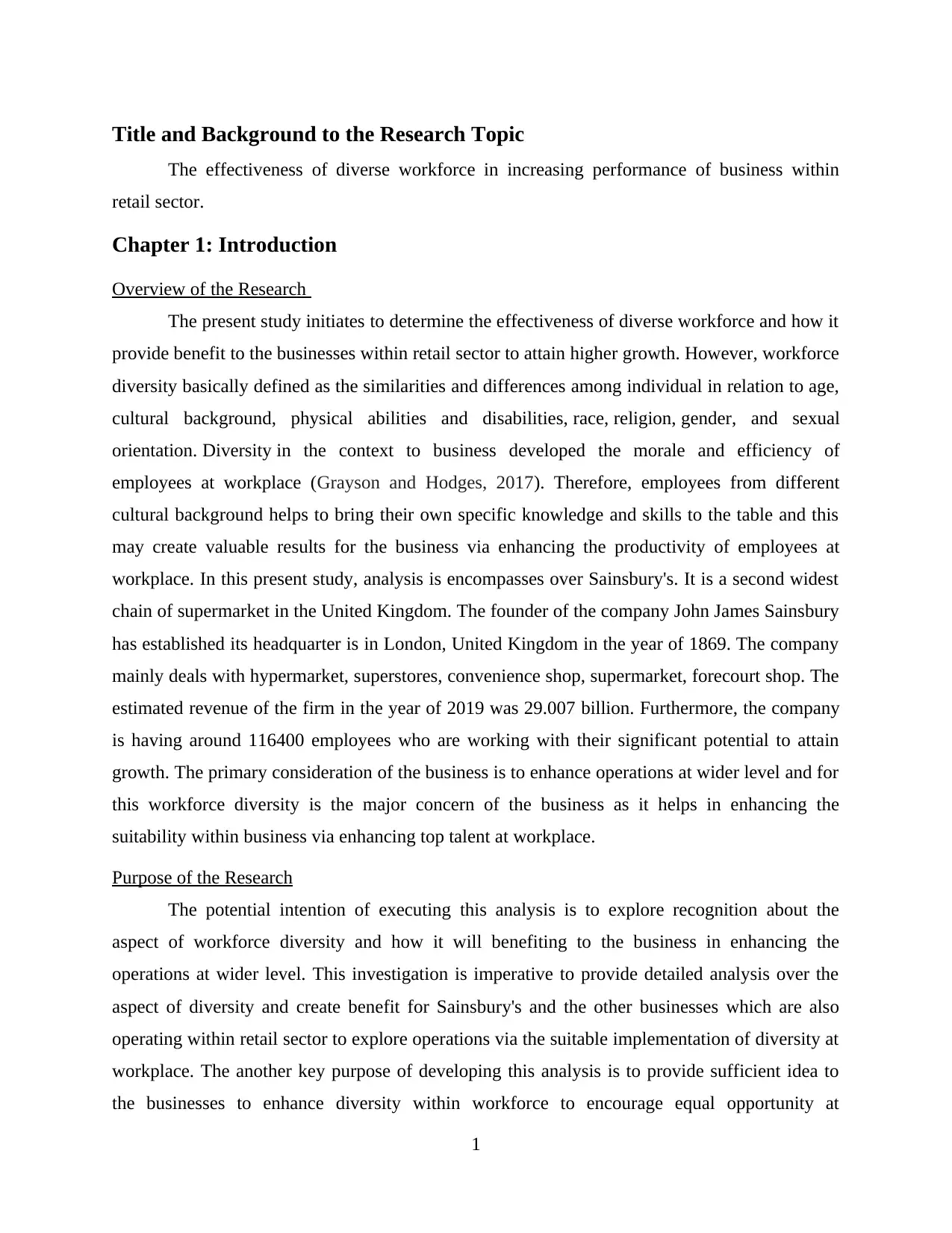
Title and Background to the Research Topic
The effectiveness of diverse workforce in increasing performance of business within
retail sector.
Chapter 1: Introduction
Overview of the Research
The present study initiates to determine the effectiveness of diverse workforce and how it
provide benefit to the businesses within retail sector to attain higher growth. However, workforce
diversity basically defined as the similarities and differences among individual in relation to age,
cultural background, physical abilities and disabilities, race, religion, gender, and sexual
orientation. Diversity in the context to business developed the morale and efficiency of
employees at workplace (Grayson and Hodges, 2017). Therefore, employees from different
cultural background helps to bring their own specific knowledge and skills to the table and this
may create valuable results for the business via enhancing the productivity of employees at
workplace. In this present study, analysis is encompasses over Sainsbury's. It is a second widest
chain of supermarket in the United Kingdom. The founder of the company John James Sainsbury
has established its headquarter is in London, United Kingdom in the year of 1869. The company
mainly deals with hypermarket, superstores, convenience shop, supermarket, forecourt shop. The
estimated revenue of the firm in the year of 2019 was 29.007 billion. Furthermore, the company
is having around 116400 employees who are working with their significant potential to attain
growth. The primary consideration of the business is to enhance operations at wider level and for
this workforce diversity is the major concern of the business as it helps in enhancing the
suitability within business via enhancing top talent at workplace.
Purpose of the Research
The potential intention of executing this analysis is to explore recognition about the
aspect of workforce diversity and how it will benefiting to the business in enhancing the
operations at wider level. This investigation is imperative to provide detailed analysis over the
aspect of diversity and create benefit for Sainsbury's and the other businesses which are also
operating within retail sector to explore operations via the suitable implementation of diversity at
workplace. The another key purpose of developing this analysis is to provide sufficient idea to
the businesses to enhance diversity within workforce to encourage equal opportunity at
1
The effectiveness of diverse workforce in increasing performance of business within
retail sector.
Chapter 1: Introduction
Overview of the Research
The present study initiates to determine the effectiveness of diverse workforce and how it
provide benefit to the businesses within retail sector to attain higher growth. However, workforce
diversity basically defined as the similarities and differences among individual in relation to age,
cultural background, physical abilities and disabilities, race, religion, gender, and sexual
orientation. Diversity in the context to business developed the morale and efficiency of
employees at workplace (Grayson and Hodges, 2017). Therefore, employees from different
cultural background helps to bring their own specific knowledge and skills to the table and this
may create valuable results for the business via enhancing the productivity of employees at
workplace. In this present study, analysis is encompasses over Sainsbury's. It is a second widest
chain of supermarket in the United Kingdom. The founder of the company John James Sainsbury
has established its headquarter is in London, United Kingdom in the year of 1869. The company
mainly deals with hypermarket, superstores, convenience shop, supermarket, forecourt shop. The
estimated revenue of the firm in the year of 2019 was 29.007 billion. Furthermore, the company
is having around 116400 employees who are working with their significant potential to attain
growth. The primary consideration of the business is to enhance operations at wider level and for
this workforce diversity is the major concern of the business as it helps in enhancing the
suitability within business via enhancing top talent at workplace.
Purpose of the Research
The potential intention of executing this analysis is to explore recognition about the
aspect of workforce diversity and how it will benefiting to the business in enhancing the
operations at wider level. This investigation is imperative to provide detailed analysis over the
aspect of diversity and create benefit for Sainsbury's and the other businesses which are also
operating within retail sector to explore operations via the suitable implementation of diversity at
workplace. The another key purpose of developing this analysis is to provide sufficient idea to
the businesses to enhance diversity within workforce to encourage equal opportunity at
1
⊘ This is a preview!⊘
Do you want full access?
Subscribe today to unlock all pages.

Trusted by 1+ million students worldwide
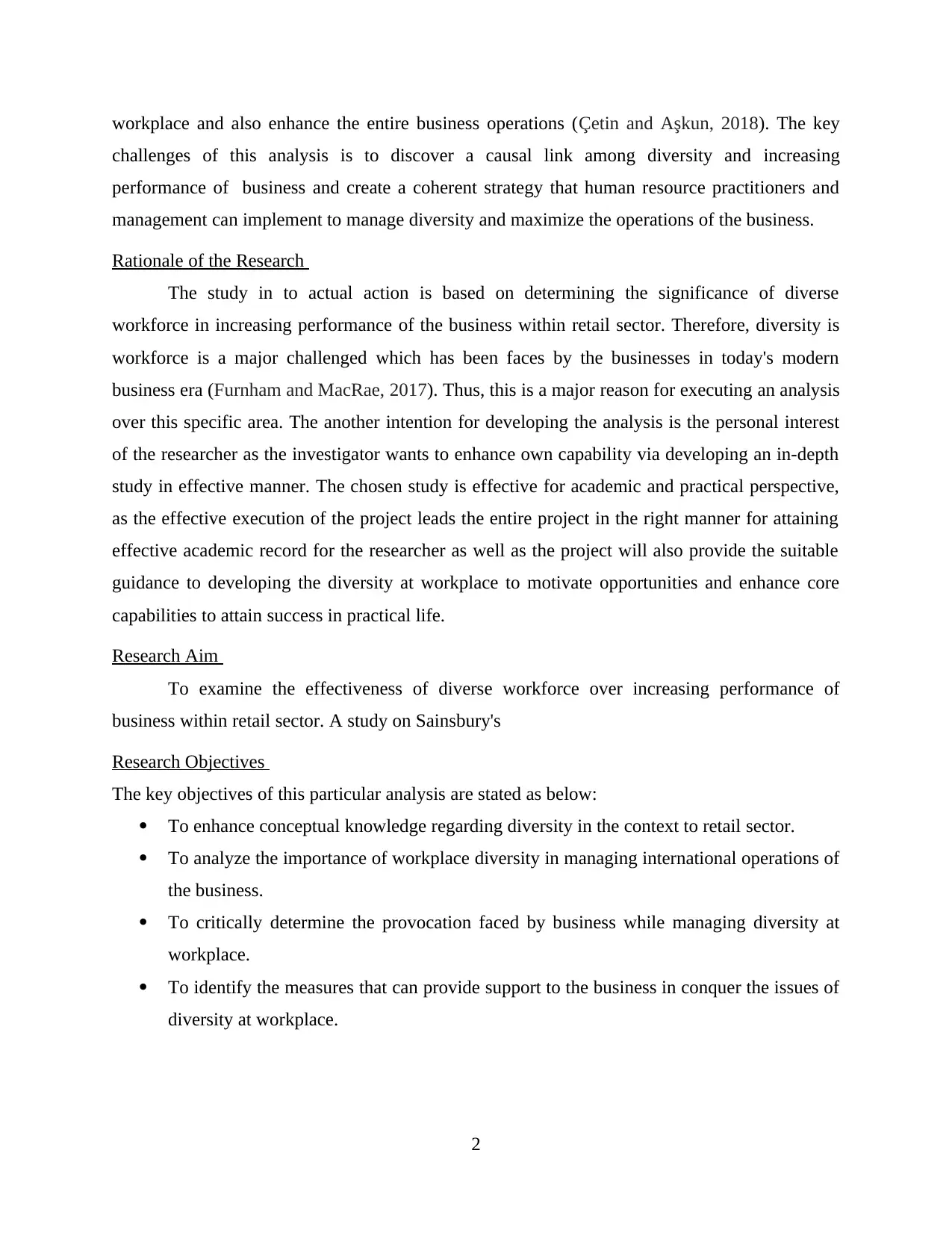
workplace and also enhance the entire business operations (Çetin and Aşkun, 2018). The key
challenges of this analysis is to discover a causal link among diversity and increasing
performance of business and create a coherent strategy that human resource practitioners and
management can implement to manage diversity and maximize the operations of the business.
Rationale of the Research
The study in to actual action is based on determining the significance of diverse
workforce in increasing performance of the business within retail sector. Therefore, diversity is
workforce is a major challenged which has been faces by the businesses in today's modern
business era (Furnham and MacRae, 2017). Thus, this is a major reason for executing an analysis
over this specific area. The another intention for developing the analysis is the personal interest
of the researcher as the investigator wants to enhance own capability via developing an in-depth
study in effective manner. The chosen study is effective for academic and practical perspective,
as the effective execution of the project leads the entire project in the right manner for attaining
effective academic record for the researcher as well as the project will also provide the suitable
guidance to developing the diversity at workplace to motivate opportunities and enhance core
capabilities to attain success in practical life.
Research Aim
To examine the effectiveness of diverse workforce over increasing performance of
business within retail sector. A study on Sainsbury's
Research Objectives
The key objectives of this particular analysis are stated as below:
To enhance conceptual knowledge regarding diversity in the context to retail sector.
To analyze the importance of workplace diversity in managing international operations of
the business.
To critically determine the provocation faced by business while managing diversity at
workplace.
To identify the measures that can provide support to the business in conquer the issues of
diversity at workplace.
2
challenges of this analysis is to discover a causal link among diversity and increasing
performance of business and create a coherent strategy that human resource practitioners and
management can implement to manage diversity and maximize the operations of the business.
Rationale of the Research
The study in to actual action is based on determining the significance of diverse
workforce in increasing performance of the business within retail sector. Therefore, diversity is
workforce is a major challenged which has been faces by the businesses in today's modern
business era (Furnham and MacRae, 2017). Thus, this is a major reason for executing an analysis
over this specific area. The another intention for developing the analysis is the personal interest
of the researcher as the investigator wants to enhance own capability via developing an in-depth
study in effective manner. The chosen study is effective for academic and practical perspective,
as the effective execution of the project leads the entire project in the right manner for attaining
effective academic record for the researcher as well as the project will also provide the suitable
guidance to developing the diversity at workplace to motivate opportunities and enhance core
capabilities to attain success in practical life.
Research Aim
To examine the effectiveness of diverse workforce over increasing performance of
business within retail sector. A study on Sainsbury's
Research Objectives
The key objectives of this particular analysis are stated as below:
To enhance conceptual knowledge regarding diversity in the context to retail sector.
To analyze the importance of workplace diversity in managing international operations of
the business.
To critically determine the provocation faced by business while managing diversity at
workplace.
To identify the measures that can provide support to the business in conquer the issues of
diversity at workplace.
2
Paraphrase This Document
Need a fresh take? Get an instant paraphrase of this document with our AI Paraphraser
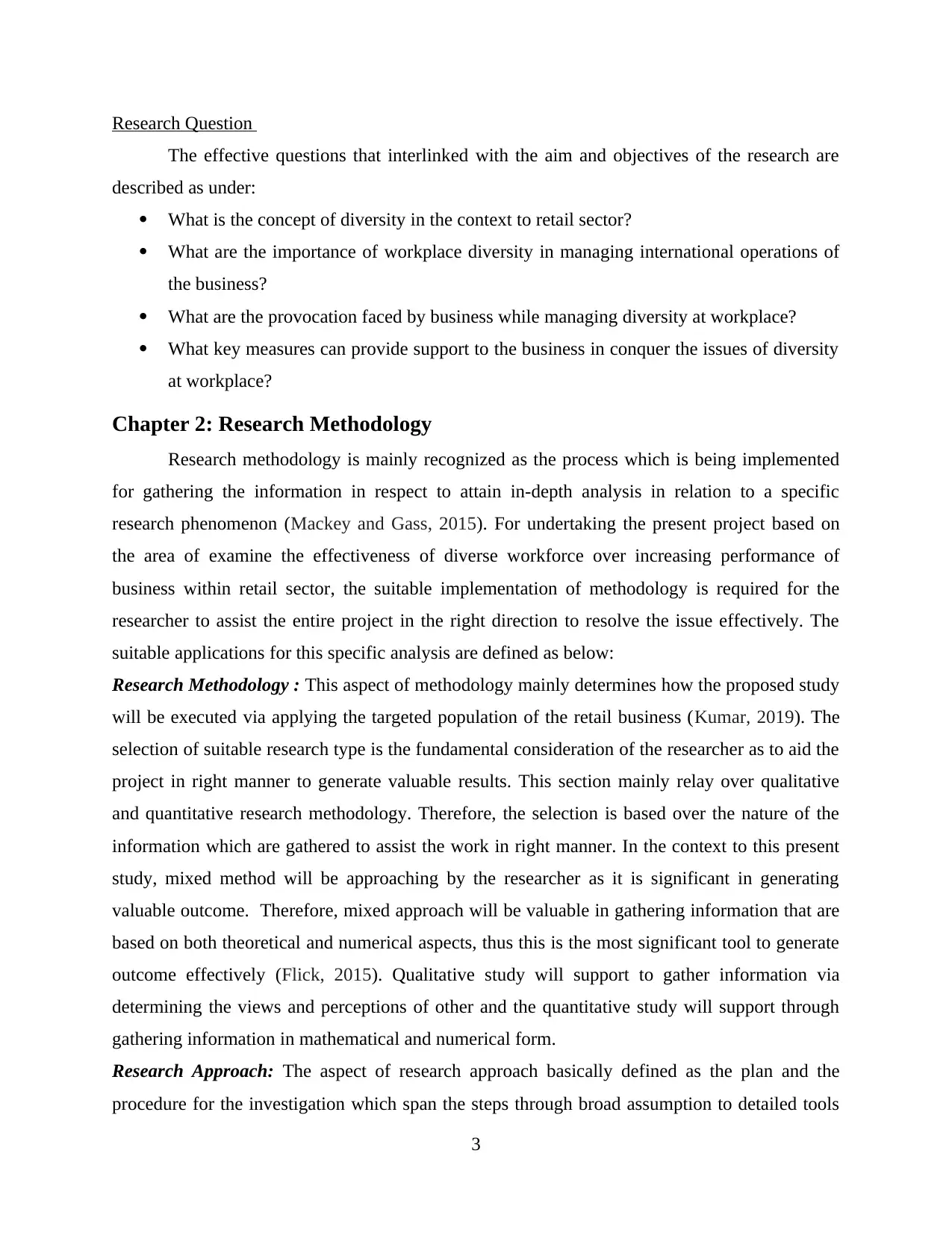
Research Question
The effective questions that interlinked with the aim and objectives of the research are
described as under:
What is the concept of diversity in the context to retail sector?
What are the importance of workplace diversity in managing international operations of
the business?
What are the provocation faced by business while managing diversity at workplace?
What key measures can provide support to the business in conquer the issues of diversity
at workplace?
Chapter 2: Research Methodology
Research methodology is mainly recognized as the process which is being implemented
for gathering the information in respect to attain in-depth analysis in relation to a specific
research phenomenon (Mackey and Gass, 2015). For undertaking the present project based on
the area of examine the effectiveness of diverse workforce over increasing performance of
business within retail sector, the suitable implementation of methodology is required for the
researcher to assist the entire project in the right direction to resolve the issue effectively. The
suitable applications for this specific analysis are defined as below:
Research Methodology : This aspect of methodology mainly determines how the proposed study
will be executed via applying the targeted population of the retail business (Kumar, 2019). The
selection of suitable research type is the fundamental consideration of the researcher as to aid the
project in right manner to generate valuable results. This section mainly relay over qualitative
and quantitative research methodology. Therefore, the selection is based over the nature of the
information which are gathered to assist the work in right manner. In the context to this present
study, mixed method will be approaching by the researcher as it is significant in generating
valuable outcome. Therefore, mixed approach will be valuable in gathering information that are
based on both theoretical and numerical aspects, thus this is the most significant tool to generate
outcome effectively (Flick, 2015). Qualitative study will support to gather information via
determining the views and perceptions of other and the quantitative study will support through
gathering information in mathematical and numerical form.
Research Approach: The aspect of research approach basically defined as the plan and the
procedure for the investigation which span the steps through broad assumption to detailed tools
3
The effective questions that interlinked with the aim and objectives of the research are
described as under:
What is the concept of diversity in the context to retail sector?
What are the importance of workplace diversity in managing international operations of
the business?
What are the provocation faced by business while managing diversity at workplace?
What key measures can provide support to the business in conquer the issues of diversity
at workplace?
Chapter 2: Research Methodology
Research methodology is mainly recognized as the process which is being implemented
for gathering the information in respect to attain in-depth analysis in relation to a specific
research phenomenon (Mackey and Gass, 2015). For undertaking the present project based on
the area of examine the effectiveness of diverse workforce over increasing performance of
business within retail sector, the suitable implementation of methodology is required for the
researcher to assist the entire project in the right direction to resolve the issue effectively. The
suitable applications for this specific analysis are defined as below:
Research Methodology : This aspect of methodology mainly determines how the proposed study
will be executed via applying the targeted population of the retail business (Kumar, 2019). The
selection of suitable research type is the fundamental consideration of the researcher as to aid the
project in right manner to generate valuable results. This section mainly relay over qualitative
and quantitative research methodology. Therefore, the selection is based over the nature of the
information which are gathered to assist the work in right manner. In the context to this present
study, mixed method will be approaching by the researcher as it is significant in generating
valuable outcome. Therefore, mixed approach will be valuable in gathering information that are
based on both theoretical and numerical aspects, thus this is the most significant tool to generate
outcome effectively (Flick, 2015). Qualitative study will support to gather information via
determining the views and perceptions of other and the quantitative study will support through
gathering information in mathematical and numerical form.
Research Approach: The aspect of research approach basically defined as the plan and the
procedure for the investigation which span the steps through broad assumption to detailed tools
3
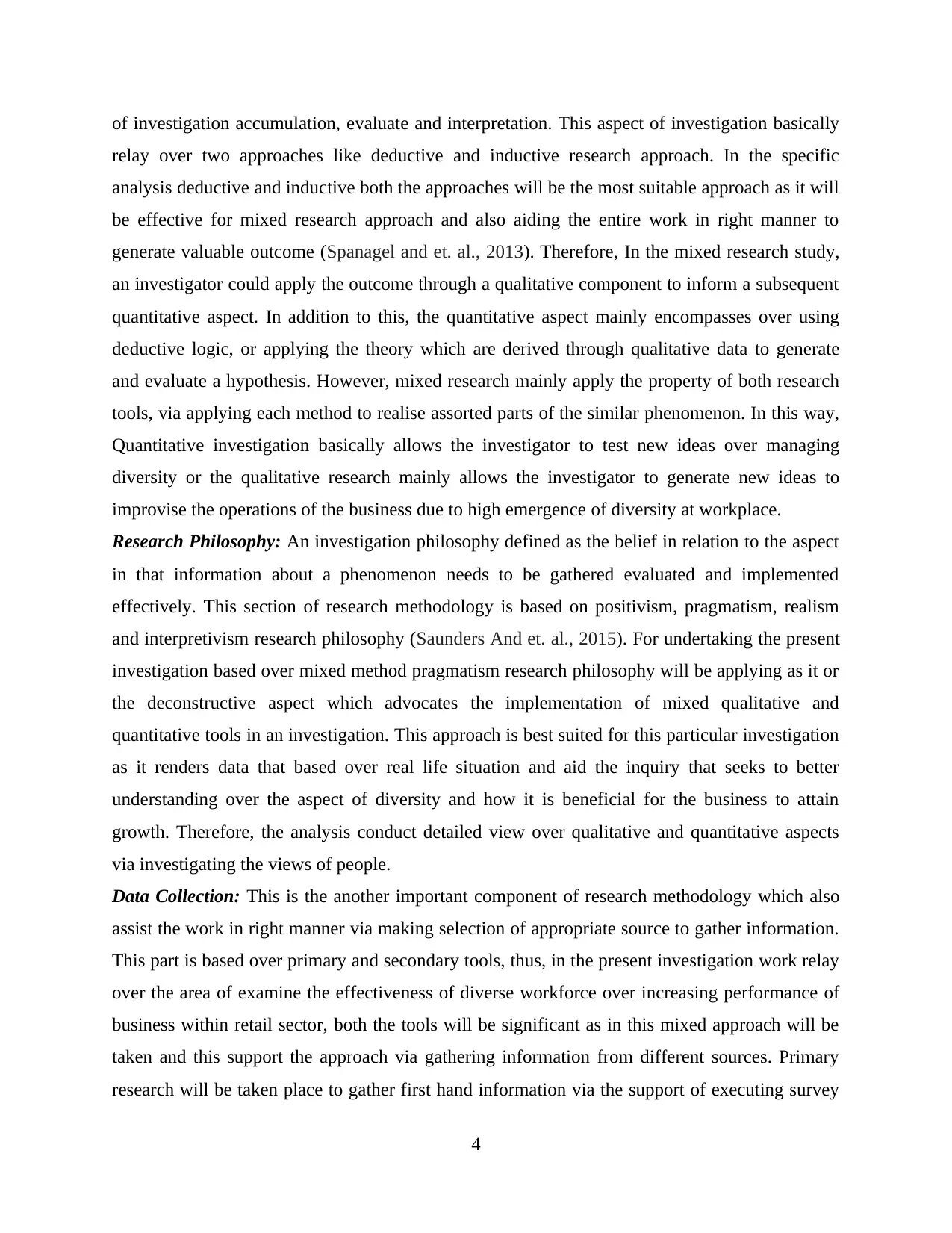
of investigation accumulation, evaluate and interpretation. This aspect of investigation basically
relay over two approaches like deductive and inductive research approach. In the specific
analysis deductive and inductive both the approaches will be the most suitable approach as it will
be effective for mixed research approach and also aiding the entire work in right manner to
generate valuable outcome (Spanagel and et. al., 2013). Therefore, In the mixed research study,
an investigator could apply the outcome through a qualitative component to inform a subsequent
quantitative aspect. In addition to this, the quantitative aspect mainly encompasses over using
deductive logic, or applying the theory which are derived through qualitative data to generate
and evaluate a hypothesis. However, mixed research mainly apply the property of both research
tools, via applying each method to realise assorted parts of the similar phenomenon. In this way,
Quantitative investigation basically allows the investigator to test new ideas over managing
diversity or the qualitative research mainly allows the investigator to generate new ideas to
improvise the operations of the business due to high emergence of diversity at workplace.
Research Philosophy: An investigation philosophy defined as the belief in relation to the aspect
in that information about a phenomenon needs to be gathered evaluated and implemented
effectively. This section of research methodology is based on positivism, pragmatism, realism
and interpretivism research philosophy (Saunders And et. al., 2015). For undertaking the present
investigation based over mixed method pragmatism research philosophy will be applying as it or
the deconstructive aspect which advocates the implementation of mixed qualitative and
quantitative tools in an investigation. This approach is best suited for this particular investigation
as it renders data that based over real life situation and aid the inquiry that seeks to better
understanding over the aspect of diversity and how it is beneficial for the business to attain
growth. Therefore, the analysis conduct detailed view over qualitative and quantitative aspects
via investigating the views of people.
Data Collection: This is the another important component of research methodology which also
assist the work in right manner via making selection of appropriate source to gather information.
This part is based over primary and secondary tools, thus, in the present investigation work relay
over the area of examine the effectiveness of diverse workforce over increasing performance of
business within retail sector, both the tools will be significant as in this mixed approach will be
taken and this support the approach via gathering information from different sources. Primary
research will be taken place to gather first hand information via the support of executing survey
4
relay over two approaches like deductive and inductive research approach. In the specific
analysis deductive and inductive both the approaches will be the most suitable approach as it will
be effective for mixed research approach and also aiding the entire work in right manner to
generate valuable outcome (Spanagel and et. al., 2013). Therefore, In the mixed research study,
an investigator could apply the outcome through a qualitative component to inform a subsequent
quantitative aspect. In addition to this, the quantitative aspect mainly encompasses over using
deductive logic, or applying the theory which are derived through qualitative data to generate
and evaluate a hypothesis. However, mixed research mainly apply the property of both research
tools, via applying each method to realise assorted parts of the similar phenomenon. In this way,
Quantitative investigation basically allows the investigator to test new ideas over managing
diversity or the qualitative research mainly allows the investigator to generate new ideas to
improvise the operations of the business due to high emergence of diversity at workplace.
Research Philosophy: An investigation philosophy defined as the belief in relation to the aspect
in that information about a phenomenon needs to be gathered evaluated and implemented
effectively. This section of research methodology is based on positivism, pragmatism, realism
and interpretivism research philosophy (Saunders And et. al., 2015). For undertaking the present
investigation based over mixed method pragmatism research philosophy will be applying as it or
the deconstructive aspect which advocates the implementation of mixed qualitative and
quantitative tools in an investigation. This approach is best suited for this particular investigation
as it renders data that based over real life situation and aid the inquiry that seeks to better
understanding over the aspect of diversity and how it is beneficial for the business to attain
growth. Therefore, the analysis conduct detailed view over qualitative and quantitative aspects
via investigating the views of people.
Data Collection: This is the another important component of research methodology which also
assist the work in right manner via making selection of appropriate source to gather information.
This part is based over primary and secondary tools, thus, in the present investigation work relay
over the area of examine the effectiveness of diverse workforce over increasing performance of
business within retail sector, both the tools will be significant as in this mixed approach will be
taken and this support the approach via gathering information from different sources. Primary
research will be taken place to gather first hand information via the support of executing survey
4
⊘ This is a preview!⊘
Do you want full access?
Subscribe today to unlock all pages.

Trusted by 1+ million students worldwide
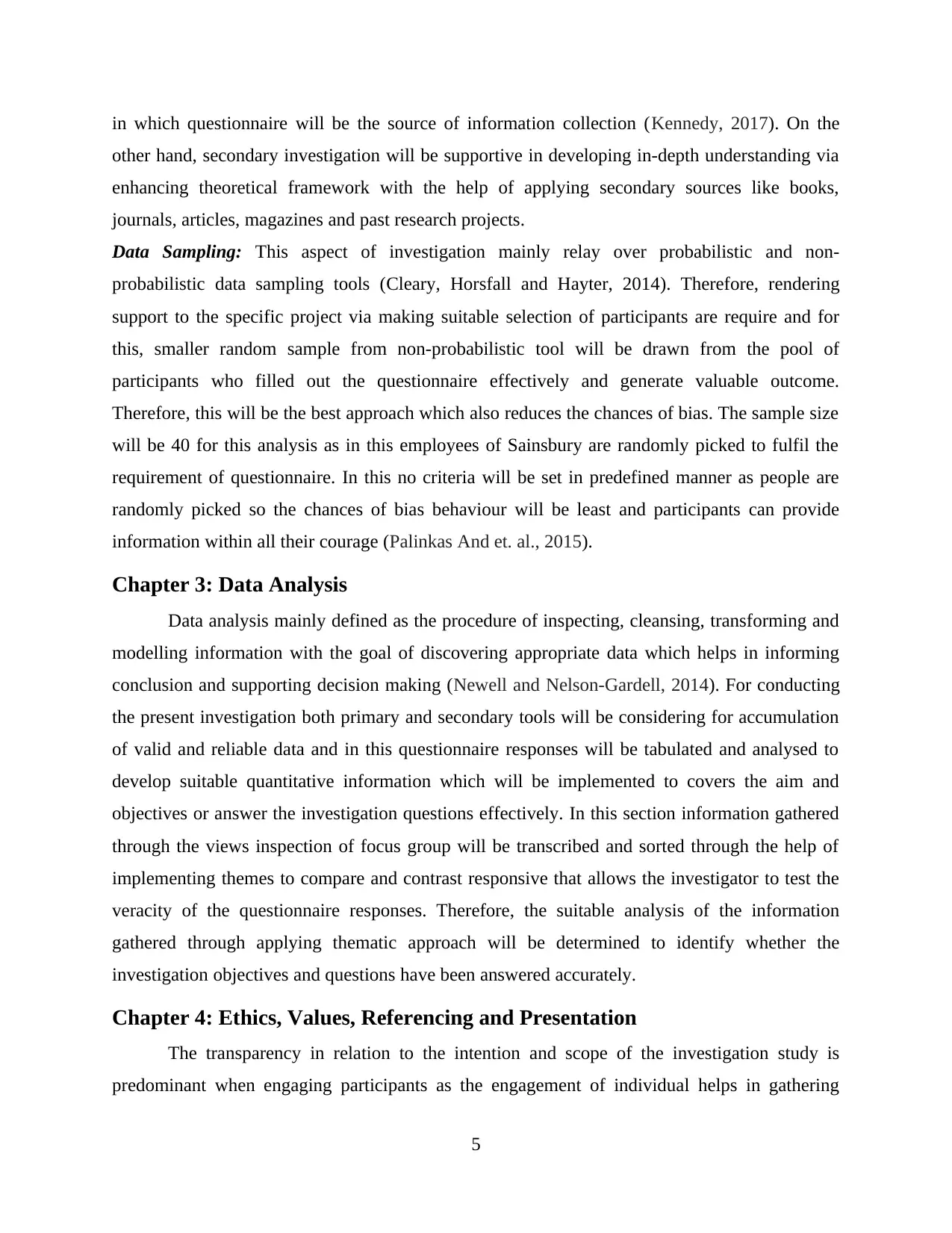
in which questionnaire will be the source of information collection (Kennedy, 2017). On the
other hand, secondary investigation will be supportive in developing in-depth understanding via
enhancing theoretical framework with the help of applying secondary sources like books,
journals, articles, magazines and past research projects.
Data Sampling: This aspect of investigation mainly relay over probabilistic and non-
probabilistic data sampling tools (Cleary, Horsfall and Hayter, 2014). Therefore, rendering
support to the specific project via making suitable selection of participants are require and for
this, smaller random sample from non-probabilistic tool will be drawn from the pool of
participants who filled out the questionnaire effectively and generate valuable outcome.
Therefore, this will be the best approach which also reduces the chances of bias. The sample size
will be 40 for this analysis as in this employees of Sainsbury are randomly picked to fulfil the
requirement of questionnaire. In this no criteria will be set in predefined manner as people are
randomly picked so the chances of bias behaviour will be least and participants can provide
information within all their courage (Palinkas And et. al., 2015).
Chapter 3: Data Analysis
Data analysis mainly defined as the procedure of inspecting, cleansing, transforming and
modelling information with the goal of discovering appropriate data which helps in informing
conclusion and supporting decision making (Newell and Nelson-Gardell, 2014). For conducting
the present investigation both primary and secondary tools will be considering for accumulation
of valid and reliable data and in this questionnaire responses will be tabulated and analysed to
develop suitable quantitative information which will be implemented to covers the aim and
objectives or answer the investigation questions effectively. In this section information gathered
through the views inspection of focus group will be transcribed and sorted through the help of
implementing themes to compare and contrast responsive that allows the investigator to test the
veracity of the questionnaire responses. Therefore, the suitable analysis of the information
gathered through applying thematic approach will be determined to identify whether the
investigation objectives and questions have been answered accurately.
Chapter 4: Ethics, Values, Referencing and Presentation
The transparency in relation to the intention and scope of the investigation study is
predominant when engaging participants as the engagement of individual helps in gathering
5
other hand, secondary investigation will be supportive in developing in-depth understanding via
enhancing theoretical framework with the help of applying secondary sources like books,
journals, articles, magazines and past research projects.
Data Sampling: This aspect of investigation mainly relay over probabilistic and non-
probabilistic data sampling tools (Cleary, Horsfall and Hayter, 2014). Therefore, rendering
support to the specific project via making suitable selection of participants are require and for
this, smaller random sample from non-probabilistic tool will be drawn from the pool of
participants who filled out the questionnaire effectively and generate valuable outcome.
Therefore, this will be the best approach which also reduces the chances of bias. The sample size
will be 40 for this analysis as in this employees of Sainsbury are randomly picked to fulfil the
requirement of questionnaire. In this no criteria will be set in predefined manner as people are
randomly picked so the chances of bias behaviour will be least and participants can provide
information within all their courage (Palinkas And et. al., 2015).
Chapter 3: Data Analysis
Data analysis mainly defined as the procedure of inspecting, cleansing, transforming and
modelling information with the goal of discovering appropriate data which helps in informing
conclusion and supporting decision making (Newell and Nelson-Gardell, 2014). For conducting
the present investigation both primary and secondary tools will be considering for accumulation
of valid and reliable data and in this questionnaire responses will be tabulated and analysed to
develop suitable quantitative information which will be implemented to covers the aim and
objectives or answer the investigation questions effectively. In this section information gathered
through the views inspection of focus group will be transcribed and sorted through the help of
implementing themes to compare and contrast responsive that allows the investigator to test the
veracity of the questionnaire responses. Therefore, the suitable analysis of the information
gathered through applying thematic approach will be determined to identify whether the
investigation objectives and questions have been answered accurately.
Chapter 4: Ethics, Values, Referencing and Presentation
The transparency in relation to the intention and scope of the investigation study is
predominant when engaging participants as the engagement of individual helps in gathering
5
Paraphrase This Document
Need a fresh take? Get an instant paraphrase of this document with our AI Paraphraser
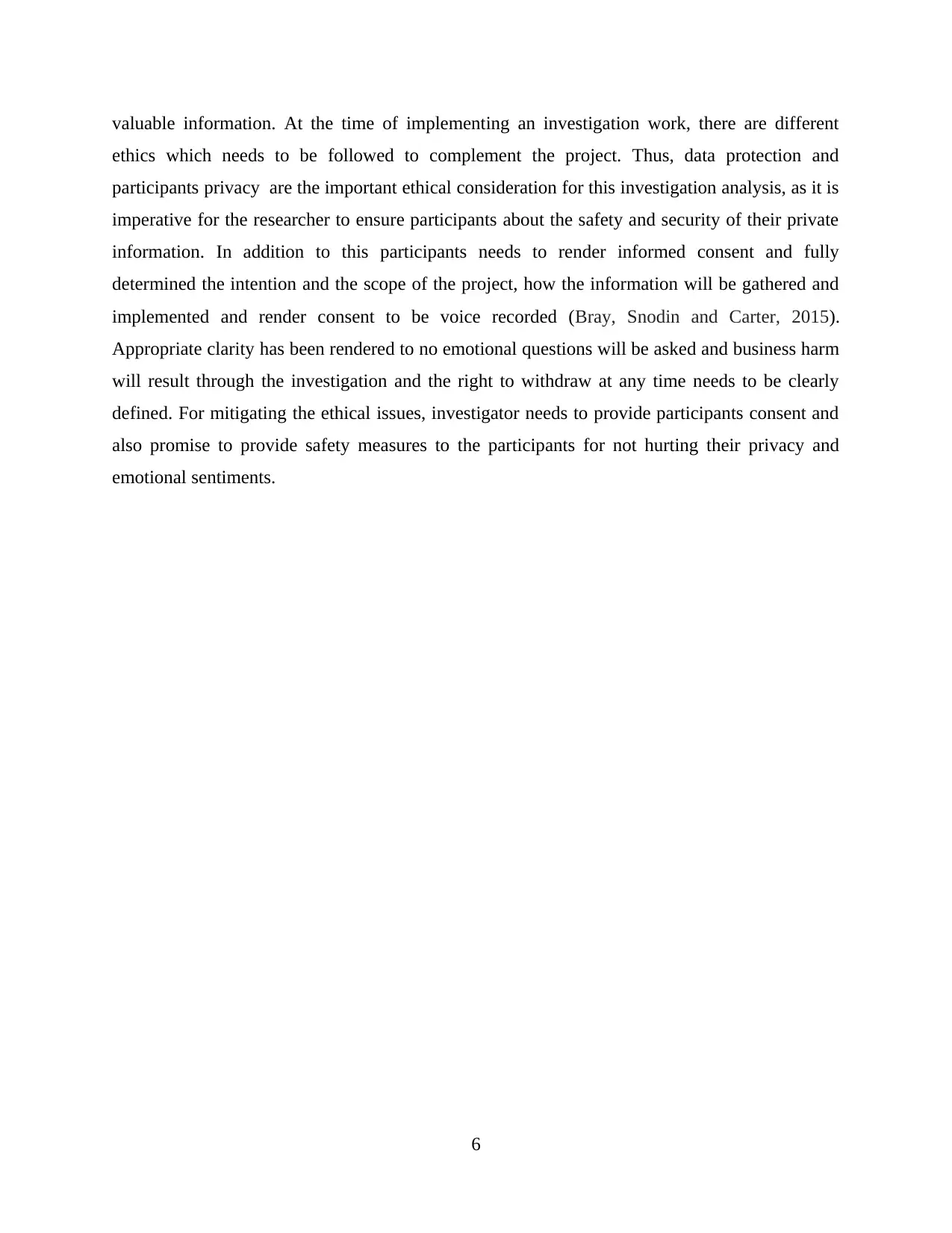
valuable information. At the time of implementing an investigation work, there are different
ethics which needs to be followed to complement the project. Thus, data protection and
participants privacy are the important ethical consideration for this investigation analysis, as it is
imperative for the researcher to ensure participants about the safety and security of their private
information. In addition to this participants needs to render informed consent and fully
determined the intention and the scope of the project, how the information will be gathered and
implemented and render consent to be voice recorded (Bray, Snodin and Carter, 2015).
Appropriate clarity has been rendered to no emotional questions will be asked and business harm
will result through the investigation and the right to withdraw at any time needs to be clearly
defined. For mitigating the ethical issues, investigator needs to provide participants consent and
also promise to provide safety measures to the participants for not hurting their privacy and
emotional sentiments.
6
ethics which needs to be followed to complement the project. Thus, data protection and
participants privacy are the important ethical consideration for this investigation analysis, as it is
imperative for the researcher to ensure participants about the safety and security of their private
information. In addition to this participants needs to render informed consent and fully
determined the intention and the scope of the project, how the information will be gathered and
implemented and render consent to be voice recorded (Bray, Snodin and Carter, 2015).
Appropriate clarity has been rendered to no emotional questions will be asked and business harm
will result through the investigation and the right to withdraw at any time needs to be clearly
defined. For mitigating the ethical issues, investigator needs to provide participants consent and
also promise to provide safety measures to the participants for not hurting their privacy and
emotional sentiments.
6
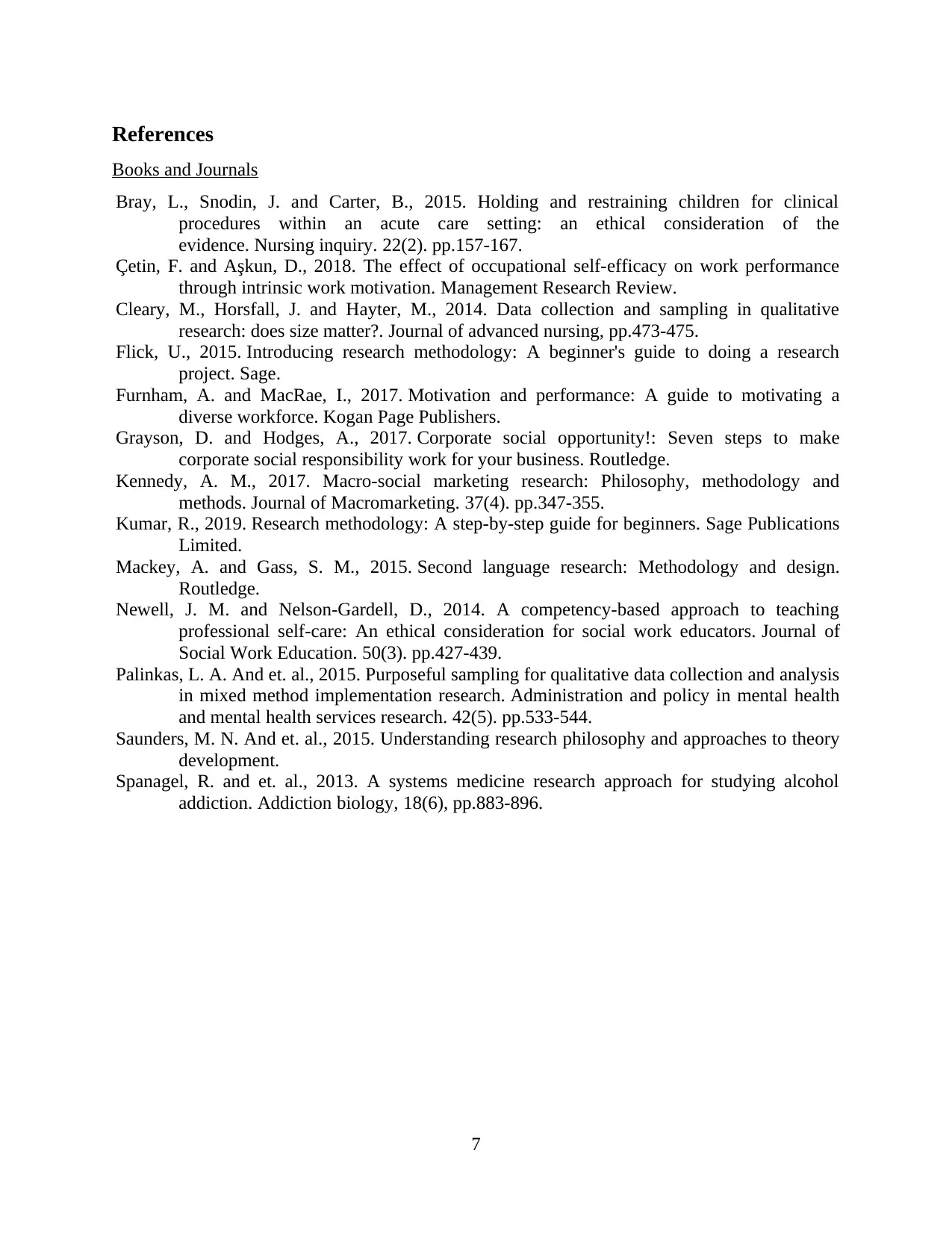
References
Books and Journals
Bray, L., Snodin, J. and Carter, B., 2015. Holding and restraining children for clinical
procedures within an acute care setting: an ethical consideration of the
evidence. Nursing inquiry. 22(2). pp.157-167.
Çetin, F. and Aşkun, D., 2018. The effect of occupational self-efficacy on work performance
through intrinsic work motivation. Management Research Review.
Cleary, M., Horsfall, J. and Hayter, M., 2014. Data collection and sampling in qualitative
research: does size matter?. Journal of advanced nursing, pp.473-475.
Flick, U., 2015. Introducing research methodology: A beginner's guide to doing a research
project. Sage.
Furnham, A. and MacRae, I., 2017. Motivation and performance: A guide to motivating a
diverse workforce. Kogan Page Publishers.
Grayson, D. and Hodges, A., 2017. Corporate social opportunity!: Seven steps to make
corporate social responsibility work for your business. Routledge.
Kennedy, A. M., 2017. Macro-social marketing research: Philosophy, methodology and
methods. Journal of Macromarketing. 37(4). pp.347-355.
Kumar, R., 2019. Research methodology: A step-by-step guide for beginners. Sage Publications
Limited.
Mackey, A. and Gass, S. M., 2015. Second language research: Methodology and design.
Routledge.
Newell, J. M. and Nelson-Gardell, D., 2014. A competency-based approach to teaching
professional self-care: An ethical consideration for social work educators. Journal of
Social Work Education. 50(3). pp.427-439.
Palinkas, L. A. And et. al., 2015. Purposeful sampling for qualitative data collection and analysis
in mixed method implementation research. Administration and policy in mental health
and mental health services research. 42(5). pp.533-544.
Saunders, M. N. And et. al., 2015. Understanding research philosophy and approaches to theory
development.
Spanagel, R. and et. al., 2013. A systems medicine research approach for studying alcohol
addiction. Addiction biology, 18(6), pp.883-896.
7
Books and Journals
Bray, L., Snodin, J. and Carter, B., 2015. Holding and restraining children for clinical
procedures within an acute care setting: an ethical consideration of the
evidence. Nursing inquiry. 22(2). pp.157-167.
Çetin, F. and Aşkun, D., 2018. The effect of occupational self-efficacy on work performance
through intrinsic work motivation. Management Research Review.
Cleary, M., Horsfall, J. and Hayter, M., 2014. Data collection and sampling in qualitative
research: does size matter?. Journal of advanced nursing, pp.473-475.
Flick, U., 2015. Introducing research methodology: A beginner's guide to doing a research
project. Sage.
Furnham, A. and MacRae, I., 2017. Motivation and performance: A guide to motivating a
diverse workforce. Kogan Page Publishers.
Grayson, D. and Hodges, A., 2017. Corporate social opportunity!: Seven steps to make
corporate social responsibility work for your business. Routledge.
Kennedy, A. M., 2017. Macro-social marketing research: Philosophy, methodology and
methods. Journal of Macromarketing. 37(4). pp.347-355.
Kumar, R., 2019. Research methodology: A step-by-step guide for beginners. Sage Publications
Limited.
Mackey, A. and Gass, S. M., 2015. Second language research: Methodology and design.
Routledge.
Newell, J. M. and Nelson-Gardell, D., 2014. A competency-based approach to teaching
professional self-care: An ethical consideration for social work educators. Journal of
Social Work Education. 50(3). pp.427-439.
Palinkas, L. A. And et. al., 2015. Purposeful sampling for qualitative data collection and analysis
in mixed method implementation research. Administration and policy in mental health
and mental health services research. 42(5). pp.533-544.
Saunders, M. N. And et. al., 2015. Understanding research philosophy and approaches to theory
development.
Spanagel, R. and et. al., 2013. A systems medicine research approach for studying alcohol
addiction. Addiction biology, 18(6), pp.883-896.
7
⊘ This is a preview!⊘
Do you want full access?
Subscribe today to unlock all pages.

Trusted by 1+ million students worldwide
1 out of 9
Related Documents
Your All-in-One AI-Powered Toolkit for Academic Success.
+13062052269
info@desklib.com
Available 24*7 on WhatsApp / Email
![[object Object]](/_next/static/media/star-bottom.7253800d.svg)
Unlock your academic potential
Copyright © 2020–2025 A2Z Services. All Rights Reserved. Developed and managed by ZUCOL.





